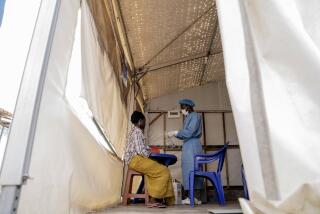Gonorrhea rate at an all-time low, but syphilis and chlamydia rates continue to rise
- Share via
The rate of gonorrhea in the United States is at an all-time low, the Centers for Disease Control and Prevention said Monday, but the rates for chlamydia and syphilis continue to rise. The three sexually transmitted diseases, orSTDs, together account for about 1.5 million cases annually, less than 10% of the country’s estimated 19 million cases. But they are the only ones that must be reported to CDC by doctors because they have such potentially serious consequences.
Herpes and human papillomavirus account for the bulk of the remaining STD infections.
All three are bacterial diseases that can be readily treated with antibiotics. Left untreated, however, they can have serious consequences. Gonorrhea and chlamydia can produce pelvic inflammatory disease in women, which can cause infertility. Each year, about 24,000 U.S. women become infertile as a result. Syphilis can cause brain, cardiovascular and organ damage. In pregnant women, it can cause congenital syphilis, which can cause stillbirth, death soon after birth and physical deformities and neurological complications in children who survive. Untreated, it causes infant death in as many as 40% of infants. Lack of treatment of the infections also appears to increase the risk of contracting HIV.
According to the new CDC report, gonorrhea cases declined 74% from 1974 to 1996 before plateauing for 10 years, then decreasing for another three. In 2009, a total of 301,174 cases were reported, with the highest rate in the South. Rates were similar in men and women, but slightly higher in women, and highest among those ages 15 to 24. In men, they were highest among those ages 20 to 24. The rate in black men was 26 times that in white men, while the rate in black women was 17 times that in white women.
A total of 1,244,180 cases of chlamydia were reported to the CDC in 2009, the highest number of cases ever reported to the agency for any condition. The CDC estimates that this is about half the actual incidence of the disease. Rates have been climbing since the 1980s when public programs for screening and treatment were first implemented, and authorities attribute the growth in reported cases to better screening. The rate is almost three times as high among women as among men, reflecting the large number of women screened for the disease. The rate in black men was 12 times that in white men, while that in black women was nearly eight times higher than that in white women.
The rate of primary and secondary syphilis in the U.S. decreased through the 1990s, and in 2000 it was the lowest since reporting began in 1941, leading the surgeon general to issue a plan to eliminate the disease from the country. Unfortunately, it has been staging a comeback, increasing each year since 2001, mostly in men but also in women. In 2009, a total of 13,997 cases of primary and secondary syphilis were reported to the CDC, the highest number since 1995 and a 5% increase from the preceding year. Since 2005, the rate has increased 59%.
After 14 years of decline, the number of cases of congenital syphilis reached a historic low of 339 cases in 2005, but it grew to 427 in 2005. The syphilis rate among blacks is nine times the rate among whites, which is a definite improvement over 1999, when the rate among blacks was 24 times that among whites.






